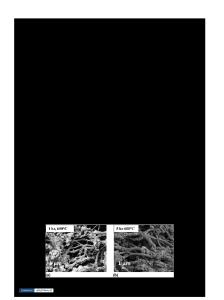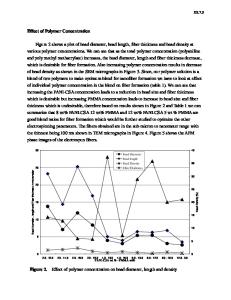Diameter control of ultrathin zinc oxide nanofibers synthesized by electrospinning
- PDF / 855,428 Bytes
- 6 Pages / 595.28 x 793.7 pts Page_size
- 1 Downloads / 414 Views
NANO EXPRESS
Open Access
Diameter control of ultrathin zinc oxide nanofibers synthesized by electrospinning Yingjie Liao1*, Takeshi Fukuda1, Norihiko Kamata1 and Makoto Tokunaga2
Abstract Electrospinning is a versatile technique, which can be used to generate nanofibers from a rich variety of materials. We investigate the variation of a zinc oxide (ZnO)-polyvinylpyrrolidone (PVP) composite structure in morphology by electrospinning from a series of mixture solutions of ZnO sol–gel and PVP. Calcination conditions for the crystallization of ZnO nanofibers and removal of the PVP component from the ZnO-PVP composite nanofibers were also studied. The progression of the ZnO-PVP composite structure from grains to nanofibers was observed, and ZnO-PVP nanofibers as thin as 29.9 ± 0.8 nm on average were successfully fabricated. The size of the resultant ZnO-PVP composite nanofibers was considerably affected by two parameters: the concentrations of zinc acetate and PVP in the precursor solution. The concentration of zinc acetate particularly influenced the diameter distribution of the ZnO-PVP nanofibers. The ZnO-PVP nanofibers could be subsequently converted into ZnO nanofibers of a pure wurtzite phase via calcination in air at 500°C for 2 h. Keywords: Zinc oxide nanofiber; Diameter control; Crystallization; Electrospinning
Background One-dimensional zinc oxide (ZnO) nanostructures have attracted considerable attention within the last decade because of unique characteristics such as large aspect ratio, high electron mobility, and electrical and optical anisotropy [1,2]. Their potential applications in various functional devices, including sensors, solar cells, photodetectors, etc., have been noted [3,4]. Most reported methods for synthesizing one-dimensional ZnO nanostructures follow vapor-solid, vapor-liquid–solid, solutionsolid, and solvothermal routes [2,5,6]. Electrospinning is a simple and versatile method along the solution-solid route for producing oxide nanofibers [4,7-10]. Although extensive investigations on the synthesis of ZnO nanofibers by electrospinning, including geometrical directional alignment [11], hydrophobicity [12], electrical properties [3,13], and growth of nanograins [14], have been reported, size control of ZnO nanofibers, especially on the 10-nm scale, has been seldom addressed. Such research, however, is important not only for understanding the mechanism of the electrospinning process * Correspondence: [email protected] 1 Department of Functional Materials Science, Graduate School of Science and Engineering, Saitama University, 255 Shimo-Okubo, Sakura-ku, Saitama 338-8570, Japan Full list of author information is available at the end of the article
but also for widening the field of geometry-dependent applications of ZnO nanofibers.
Methods In this work, a mixture of ZnO sol–gel solution and polyvinylpyrrolidone (PVP) (Mw = 1,300,000, Aldrich, St. Louis, MO, USA) in ethanol was used for electrospinning [15,16]. In a typical procedure, 43.9 mg of Zn (CH3COO)2 · 2H2O was first dissolved in a mo
Data Loading...











